Sarah L. Johnson's Blog, page 61
May 12, 2018
Article note: Interview with Mindy Tarquini and Susan Meissner about their novels on the Spanish Flu
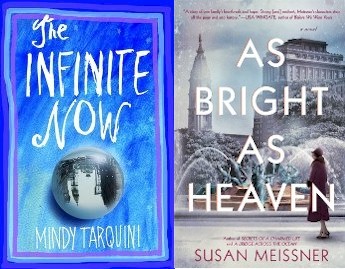
This year marks the centennial of the 1918-19 influenza pandemic; my library will be offering an exhibit program about this global public health disaster in the fall. There have been a number of historical novels published about the "Spanish flu" recently (which was nicknamed such, even though it didn't originate or hit hardest in Spain). I'll put together a list of them for a future post.
For May's Historical Novels Review, I got the idea to interview two authors, Mindy Tarquini and Susan Meissner, who both set their novels in the historical American city of Philadelphia at the time. Other than a similarity of location and topic, the books are pretty different, and their characters probably wouldn't have known one another.
This article is now posted on the Historical Novel Society's website. Please click the link to read it: Philadelphia, 1918: Susan Meissner and Mindy Tarquini discuss their new novels.
Thanks very much to both authors for answering my interview questions!
Published on May 12, 2018 12:20
May 9, 2018
Review of Alison Weir's Jane Seymour: The Haunted Queen, book three in the Six Tudor Queens series
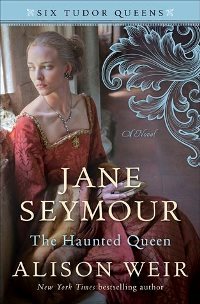 Jane Seymour, the queen who bore Henry VIII’s longed-for son and died shortly afterward, left little behind in period sources, and popular history stereotypes her as meek and plain. Best-selling Weir’s impressive novel shows why Jane deserves renewed attention. Without any dull moments, Weir illustrates Jane's unlikely journey from country knight’s daughter to queen of England.
Jane Seymour, the queen who bore Henry VIII’s longed-for son and died shortly afterward, left little behind in period sources, and popular history stereotypes her as meek and plain. Best-selling Weir’s impressive novel shows why Jane deserves renewed attention. Without any dull moments, Weir illustrates Jane's unlikely journey from country knight’s daughter to queen of England.To evade the domestic scandal stemming from her brother’s unhappy marriage, the devout, sympathetic Jane comes to court as one of Katherine of Aragon’s maids of honor. This third volume in Weir’s Six Tudor Queens series offers new angles on its earlier subjects: Katherine, aging, resolute, and losing influence, yet kind to her ladies; and sharp-tongued Anne Boleyn, whose religious beliefs Jane finds dangerous.
A woman of principle, Jane courageously holds her own among prominent court personalities, no easy feat. Later, as Anne’s influence wanes, Jane intelligently navigates a path amid a surprising romantic pursuit by King Henry, whose love and generosity initially overshadow his crueler side, and her family’s ambitions.
From the richly appointed decor to the religious tenor of the time, the historical ambiance is first-rate. With her standout novel in the crowded Tudor fiction field, Weir keeps the tension high, breathing new life into a familiar tale and making us wish for a different ending.
This starred review was published in Booklist's latest historical fiction issue (4/15/18). Jane Seymour: The Haunted Queen will be published next week by Ballantine in hardcover and ebook (576pp). I think this is the best in the series so far. One theme of this book is: don't underestimate the quiet ones. Jane is a terrific character, and her story is well worth reading even if you think you've had enough of all things Tudor.
Also: the fourth volume in the series, about Anne of Cleves, has a title and a cover on Goodreads (it's still early, so it's not clear if they're final). I really like them both -- it's a great way of presenting her in a new light from the get-go -- and hope I get the chance to review the book next year.
Published on May 09, 2018 06:00
May 7, 2018
Interview with Susan McDuffie, author of The Death of a Falcon, a mystery of 14th-century Scotland, plus US giveaway
Susan McDuffie's entertaining latest Muirteach MacPhee mystery, The Death of a Falcon, brings readers to Scotland in 1375, as our protagonist and his wife, Mariota, a talented healer, pay a visit to Edinburgh Castle. While helping his superior with political negotiations, Muirteach finds himself enmeshed in a murder mystery as well as unexpected court drama which affects him personally. I was glad to get the opportunity to ask Susan some questions about her book... please read on!
What appeals to you about writing historical mysteries?
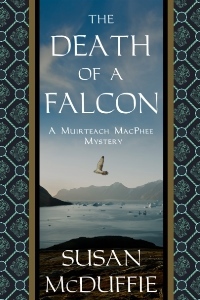 Thanks so much for hosting me on Reading the Past, Sarah. It’s such a treat to be here with you today!
Thanks so much for hosting me on Reading the Past, Sarah. It’s such a treat to be here with you today!
I’d always been a voracious reader of historical fiction but never thought much about writing until my thirties, when I made a trip to the paperback book exchange to de-stress after a difficult day of work. I found some Harlequin romances (this was back in the 80s) and thought how easy it would be to write a book and get rich and famous! Was I ever mistaken. I first tried a historical romance (still unpublished) and also wrote a couple of Regencies, which were great fun. I guess I thought romance would be easier to write than mysteries. Eventually, however, I realized that the old chestnut is true, “You must write what you love to read.” I am not an avid romance reader, but I do love historical mysteries.
I think the sense of justice restored at the end of a mystery is comforting, while the historical aspect of it cushions it a bit, and takes the same old tired motives we hear about each night in the evening news—greed, anger, revenge, lust—back into the past bit, somehow cushioning things. It’s a little easier to deal with the cruelty of humanity when they are wearing historic costumes, and it all happened 600 years ago. Long ago and far away.
Another thing that fascinates me about historical fiction is trying to really get into the heads and psyches and attitudes of people in the past. How was medieval justice different? How did people view justice differently?
The Death of a Falcon takes place during a fascinating but less familiar time in Scottish history, with its bustling trade routes to southern Europe and the Norse lands, the Orkneys under Norway’s control, and Robert II’s lively, multilingual court. How did you choose 14th-century Scotland, or how did the era choose you?
The era pretty much chose me. When I was initially developing the idea for this mystery series, I realized I wanted to set it during the Lordship of the Isles, which lasted from about 1350 to 1498. It was a fairly settled time in western Scotland, less chaotic that the couple of hundred years afterwards, when the power vacuum caused by the end of the Lordship contributed to all the horrible clan feuding of that era. I thought, it would be fun era to visit in my fiction, and an opportunity to explore that less well-known period.
The McDuffies, or MacFies, were the Keepers of the Records for the Lordship, which was a confederation of Scottish clans in the Highlands and Western Isles headed by the MacDonald. “Keeper of the Records” sounded very exotic and mysterious to me when I heard about it from my great-uncle and my father as a child. Actually, it might have been less exotic and more an accounting of who owed whom how many cattle, but I thought a role as the Keeper of the Records would give my sleuth plenty of leeway to travel and investigate things on behalf of the Lord of the Isles. The final result is Muirteach. So far he’s investigated in the Hebrides, and in Oxford. Now he and Mariota are in Edinburgh, at the Royal Court. I think he’s had enough of court life, though, by the end of The Death of a Falcon.
 author Susan McDuffieMuirteach and his wife, Mariota, go through some marital difficulties, and while Muirteach is the protagonist, I often found myself sympathizing with and rooting for Mariota. What was the experience like, writing from his viewpoint during this challenging time?
author Susan McDuffieMuirteach and his wife, Mariota, go through some marital difficulties, and while Muirteach is the protagonist, I often found myself sympathizing with and rooting for Mariota. What was the experience like, writing from his viewpoint during this challenging time?
Muirteach is a somewhat flawed character, perhaps more so in this book. When I first began writing the series I envisioned a fairly simple character arc over time with increasing wisdom and maturity, less drinking (he’s a bit of a lush in A Mass for the Dead, the first in the series). However, this book represents three steps backwards for him. When I was writing this I was reading Game of Thrones, and thinking, “Oh I really need to work on my plotting; my plots are far too predictable,” so maybe perhaps some of the credit, or blame, goes to George R. R. Martin. I wanted to break out from the typical predictable hero and ending.
In this book Muirteach also winds up repeating some of the less functional patterns of his father. Don’t we see that in families all the time? We’re all pretty flawed, really, and I like reading and writing complex characters. Although I do believe one of the reasons people like to read mysteries is that sense of justice restored at the end. I grew a bit worried, writing this book, that people would get so frustrated with Muirteach they would throw the book at the wall.
Have you gotten to travel to the places you write about in Scotland?
I have been to most of the places I’ve written about. I particularly loved the Western Isles. I need to go back soon; it’s been far too long!
Muirteach is amused and befuddled by the royal court at Edinburgh, especially the fashions. How did you research this aspect of Scottish culture?
It can be tricky researching Scottish dress before the 1600s. I’ve gone with the assumption that the Highlands and Islands had much in common with Irish fashion and culture of that era. One great resource for clothing is Old Irish and Highland Dress by H.F. McClintock. For the Lowlands, and the royal court, I’ve relied more on general medieval sources for fashion, style, and cuisine.
In the acknowledgments, you’d mentioned visiting the Santa Fe Raptor Center. What did you learn there about birds (and from Gandalf the hawk) that you might not have known otherwise?
Actually, the birds visited me, or visited my day job at a gallery in Santa Fe. During Indian Market the Raptor Center sometimes comes and sets up a display with a few of their friendlier birds in front of the shop. It’s always amazing to be in the presence of these other beings we humans share the planet with. Gandalf was a wonderful inspiration!
The idea of a lost medieval book is compelling, and a bit frustrating that it no longer exists! How did you first come across mention of the Inventio Fortunatae, and then decide to use it in your story?
I got so wonderfully sidetracked by research when writing this book. Initially I knew I wanted to include something about Prince Henry Sinclair, who may have visited North America around 1398 with the Venetian Zeno brothers. That led me to the book Irresistible North: From Venice to Greenland on the Trail of the Zen Brothers by Andrea di Robilant. But di Robilant’s view was that Henry Sinclair had only travelled to Iceland and Greenland. That led me down the Norse in Greenland rabbit-hole and I grew fascinated by their story. Where did they go?
One book that was a great reference was Erikson, Eskimos and Columbus: Medieval European Knowledge of America by James Robert Interline, and that particular book has a lot of information on the Inventio Fortunatae. The description of the giant lodestone at the North Pole, where indwelling currents sucked ships in and dashed them against the rocks, was incredibly compelling. Just imagining early exploration in this region is compelling, actually. Wouldn’t it be wonderful to find a copy of the Inventio someplace? Or even a bit of old parchment from it tucked into another binding? Or something! I guess we can always hope!
~
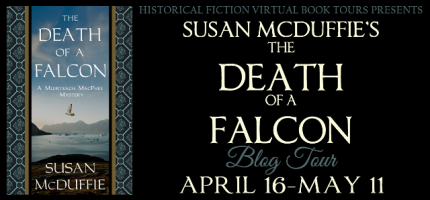
The Death of a Falcon by Susan McDuffie was published by Liafinn Press in paperback and ebook in March. This interview forms part of the author's blog tour, during which we will be giving away 5 paperback copies & 5 eBooks of The Death of a Falcon! To enter, please enter via the Gleam form below.
Giveaway Rules
– Giveaway ends at 11:59pm EST on May 11th. You must be 18 or older to enter.
– Giveaway is open to US residents only.
– Only one entry per household.
– All giveaway entrants agree to be honest and not cheat the systems; any suspect of fraud is decided upon by blog/site owner and the sponsor, and entrants may be disqualified at our discretion.
– Winner has 48 hours to claim prize or new winner is chosen.
Death of a Falcon
What appeals to you about writing historical mysteries?
 Thanks so much for hosting me on Reading the Past, Sarah. It’s such a treat to be here with you today!
Thanks so much for hosting me on Reading the Past, Sarah. It’s such a treat to be here with you today!I’d always been a voracious reader of historical fiction but never thought much about writing until my thirties, when I made a trip to the paperback book exchange to de-stress after a difficult day of work. I found some Harlequin romances (this was back in the 80s) and thought how easy it would be to write a book and get rich and famous! Was I ever mistaken. I first tried a historical romance (still unpublished) and also wrote a couple of Regencies, which were great fun. I guess I thought romance would be easier to write than mysteries. Eventually, however, I realized that the old chestnut is true, “You must write what you love to read.” I am not an avid romance reader, but I do love historical mysteries.
I think the sense of justice restored at the end of a mystery is comforting, while the historical aspect of it cushions it a bit, and takes the same old tired motives we hear about each night in the evening news—greed, anger, revenge, lust—back into the past bit, somehow cushioning things. It’s a little easier to deal with the cruelty of humanity when they are wearing historic costumes, and it all happened 600 years ago. Long ago and far away.
Another thing that fascinates me about historical fiction is trying to really get into the heads and psyches and attitudes of people in the past. How was medieval justice different? How did people view justice differently?
The Death of a Falcon takes place during a fascinating but less familiar time in Scottish history, with its bustling trade routes to southern Europe and the Norse lands, the Orkneys under Norway’s control, and Robert II’s lively, multilingual court. How did you choose 14th-century Scotland, or how did the era choose you?
The era pretty much chose me. When I was initially developing the idea for this mystery series, I realized I wanted to set it during the Lordship of the Isles, which lasted from about 1350 to 1498. It was a fairly settled time in western Scotland, less chaotic that the couple of hundred years afterwards, when the power vacuum caused by the end of the Lordship contributed to all the horrible clan feuding of that era. I thought, it would be fun era to visit in my fiction, and an opportunity to explore that less well-known period.
The McDuffies, or MacFies, were the Keepers of the Records for the Lordship, which was a confederation of Scottish clans in the Highlands and Western Isles headed by the MacDonald. “Keeper of the Records” sounded very exotic and mysterious to me when I heard about it from my great-uncle and my father as a child. Actually, it might have been less exotic and more an accounting of who owed whom how many cattle, but I thought a role as the Keeper of the Records would give my sleuth plenty of leeway to travel and investigate things on behalf of the Lord of the Isles. The final result is Muirteach. So far he’s investigated in the Hebrides, and in Oxford. Now he and Mariota are in Edinburgh, at the Royal Court. I think he’s had enough of court life, though, by the end of The Death of a Falcon.
 author Susan McDuffieMuirteach and his wife, Mariota, go through some marital difficulties, and while Muirteach is the protagonist, I often found myself sympathizing with and rooting for Mariota. What was the experience like, writing from his viewpoint during this challenging time?
author Susan McDuffieMuirteach and his wife, Mariota, go through some marital difficulties, and while Muirteach is the protagonist, I often found myself sympathizing with and rooting for Mariota. What was the experience like, writing from his viewpoint during this challenging time?Muirteach is a somewhat flawed character, perhaps more so in this book. When I first began writing the series I envisioned a fairly simple character arc over time with increasing wisdom and maturity, less drinking (he’s a bit of a lush in A Mass for the Dead, the first in the series). However, this book represents three steps backwards for him. When I was writing this I was reading Game of Thrones, and thinking, “Oh I really need to work on my plotting; my plots are far too predictable,” so maybe perhaps some of the credit, or blame, goes to George R. R. Martin. I wanted to break out from the typical predictable hero and ending.
In this book Muirteach also winds up repeating some of the less functional patterns of his father. Don’t we see that in families all the time? We’re all pretty flawed, really, and I like reading and writing complex characters. Although I do believe one of the reasons people like to read mysteries is that sense of justice restored at the end. I grew a bit worried, writing this book, that people would get so frustrated with Muirteach they would throw the book at the wall.
Have you gotten to travel to the places you write about in Scotland?
I have been to most of the places I’ve written about. I particularly loved the Western Isles. I need to go back soon; it’s been far too long!
Muirteach is amused and befuddled by the royal court at Edinburgh, especially the fashions. How did you research this aspect of Scottish culture?
It can be tricky researching Scottish dress before the 1600s. I’ve gone with the assumption that the Highlands and Islands had much in common with Irish fashion and culture of that era. One great resource for clothing is Old Irish and Highland Dress by H.F. McClintock. For the Lowlands, and the royal court, I’ve relied more on general medieval sources for fashion, style, and cuisine.
In the acknowledgments, you’d mentioned visiting the Santa Fe Raptor Center. What did you learn there about birds (and from Gandalf the hawk) that you might not have known otherwise?
Actually, the birds visited me, or visited my day job at a gallery in Santa Fe. During Indian Market the Raptor Center sometimes comes and sets up a display with a few of their friendlier birds in front of the shop. It’s always amazing to be in the presence of these other beings we humans share the planet with. Gandalf was a wonderful inspiration!
The idea of a lost medieval book is compelling, and a bit frustrating that it no longer exists! How did you first come across mention of the Inventio Fortunatae, and then decide to use it in your story?
I got so wonderfully sidetracked by research when writing this book. Initially I knew I wanted to include something about Prince Henry Sinclair, who may have visited North America around 1398 with the Venetian Zeno brothers. That led me to the book Irresistible North: From Venice to Greenland on the Trail of the Zen Brothers by Andrea di Robilant. But di Robilant’s view was that Henry Sinclair had only travelled to Iceland and Greenland. That led me down the Norse in Greenland rabbit-hole and I grew fascinated by their story. Where did they go?
One book that was a great reference was Erikson, Eskimos and Columbus: Medieval European Knowledge of America by James Robert Interline, and that particular book has a lot of information on the Inventio Fortunatae. The description of the giant lodestone at the North Pole, where indwelling currents sucked ships in and dashed them against the rocks, was incredibly compelling. Just imagining early exploration in this region is compelling, actually. Wouldn’t it be wonderful to find a copy of the Inventio someplace? Or even a bit of old parchment from it tucked into another binding? Or something! I guess we can always hope!
~

The Death of a Falcon by Susan McDuffie was published by Liafinn Press in paperback and ebook in March. This interview forms part of the author's blog tour, during which we will be giving away 5 paperback copies & 5 eBooks of The Death of a Falcon! To enter, please enter via the Gleam form below.
Giveaway Rules
– Giveaway ends at 11:59pm EST on May 11th. You must be 18 or older to enter.
– Giveaway is open to US residents only.
– Only one entry per household.
– All giveaway entrants agree to be honest and not cheat the systems; any suspect of fraud is decided upon by blog/site owner and the sponsor, and entrants may be disqualified at our discretion.
– Winner has 48 hours to claim prize or new winner is chosen.
Death of a Falcon
Published on May 07, 2018 05:00
May 3, 2018
A Fist Around the Heart by Heather Chisvin, a multi-layered literary mystery spanning six decades of women's lives
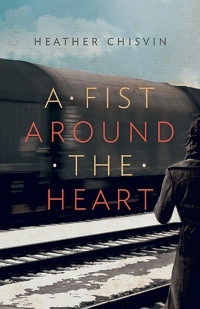 This is such a surprising book, one filled with layers inside layers and new revelations at every turn. Moving back and forth from WWII-era New York and Winnipeg and a Russian shtetl in the 1880s, and many points in between, it doesn’t offer the chronological path of a standard historical novel. However, its flow feels natural, like the unspooling of memories from a remarkable life.
This is such a surprising book, one filled with layers inside layers and new revelations at every turn. Moving back and forth from WWII-era New York and Winnipeg and a Russian shtetl in the 1880s, and many points in between, it doesn’t offer the chronological path of a standard historical novel. However, its flow feels natural, like the unspooling of memories from a remarkable life. In 1942, Anna Grieve, a well-off career woman in her sixties and longtime Manhattan resident, has just put her older sister Esther on a train back to Winnipeg after an enjoyable, long-awaited visit. Following Esther’s arrival home on “If Day,” the date of a simulated Nazi invasion, Anna receives a call from a policeman that Esther is dead; she’d walked in front of a moving train, an apparent suicide. Esther, a widowed society matron, had had episodes of mental instability from childhood on—periods when she seemed tuned out from reality—although she’d seemed fine during her stay.
As Anna herself returns to Winnipeg for answers, a mystery unfolds, drawing in reminiscences of both women’s earlier lives. In 1881, when Anna was five and Esther ten, their frightened parents, fearing anti-Semitic retaliation after Tsar Alexander II’s assassination, sent the girls away from Russia with her mother’s aristocratic employers. On their transatlantic voyage, young Anna’s confusion is palpable. Despite a comfortable upbringing, with an adoptive father who respects her intelligence, Anna worries continuously about her fragile, ethereally beautiful sister.
Anna is a woman of astonishing courage and hidden complexities. She forms friendships, has several love affairs, and participates in the early birth control movement alongside Margaret Sanger. Chisvin brings this setting alive with vibrant ease. One of Anna’s later travels feels a bit contrived, but this debut is a fine literary mystery with an insightful look at an unusual sisterly relationship.
A Fist Around the Heart (the title comes from a line in the novel) was published by Canada's Second Story Press in April. I reviewed it for May's Historical Novels Review, based on a NetGalley copy.
Published on May 03, 2018 05:00
April 30, 2018
Book review: Peculiar Savage Beauty by Jessica McCann, set in 1930s Kansas, plus US giveaway
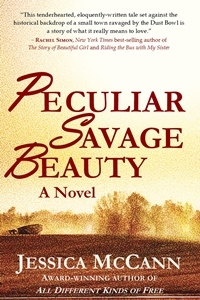 Add Jessica McCann’s Peculiar Savage Beauty to the list of exceptional new historical novels featuring women making their mark in STEM.
Add Jessica McCann’s Peculiar Savage Beauty to the list of exceptional new historical novels featuring women making their mark in STEM.Rosa Jean (RJ) Evans has just graduated from the University of Wisconsin with a geology master’s degree in 1934. Having secured a government job back in her hometown of Vanham, Kansas, a tiny farming community she left at age six after her parents died of influenza, RJ is preparing to purchase some land, set up a soil erosion experiment station, and convince local farmers – all men – to adopt conservation farming methods to help the soil revive. She has her work cut out for her.
The title comes from a passage from O Pioneers!, which also appears as the epigraph: “…the land wanted to be let alone, to preserve its own fierce strength, its peculiar, savage kind of beauty.” Willa Cather’s wise words echo strongly in McCann’s vivid descriptions of the Dust Bowl years on the Great Plains, and her themes relating to climatic disasters and the need for people to protect the environment.
 author Jessica McCannRJ proves an admirable, resourceful heroine from the outset, when she survives a dust storm while driving her truck solo from Wisconsin to Kansas. The harrowing experience also introduces her to her first friend, a stray dog she names Stormy. The other relationships RJ forms are just as heartwarming and meaningful. Woody Parker, a man about her age who we’d call autistic today, becomes her firm friend. Others label him as dim-witted, but RJ sees his thoughtfulness and brilliant artistic talents in the dust-paintings he creates in the storms’ aftermath, and he supports her when she runs into roadblocks.
author Jessica McCannRJ proves an admirable, resourceful heroine from the outset, when she survives a dust storm while driving her truck solo from Wisconsin to Kansas. The harrowing experience also introduces her to her first friend, a stray dog she names Stormy. The other relationships RJ forms are just as heartwarming and meaningful. Woody Parker, a man about her age who we’d call autistic today, becomes her firm friend. Others label him as dim-witted, but RJ sees his thoughtfulness and brilliant artistic talents in the dust-paintings he creates in the storms’ aftermath, and he supports her when she runs into roadblocks.Most of the local farmers don’t trust either “government bureaucrats” or women who claim to have knowledge they themselves don’t, when their families have been working the land for generations. There are rushes to judgment on all sides, and it’s rewarding to see characters slowly move beyond preconceptions to form understandings.
All the details on the setting bring readers back to the painful Dust Bowl years: the summer heat and never-ending drought, the mud accumulating in pipes and drinking water, the wires people strung on their property to lead them back home during a blinding storm, and the evening gatherings around the wireless for Roosevelt’s fireside chats. Excerpts from period songs add to the atmosphere (I had “Stormy Weather” playing in my head while reading), and McCann gets the cadence of the rural characters’ dialogue just right; they sound like my own Midwestern neighbors.
Although I wished for slightly more information on RJ’s earlier history, this is a compelling historical novel with a tangible sense of place. It never bends to stereotype, and its characters are well worth getting to know.
This review is the last stop on the novel's blog tour; thanks to Jessica McCann for sending me a copy at my request. Peculiar Savage Beauty is published this month by Perspective Books in hardcover ($24) and as an ebook ($8.99).
Also thanks to the author, there's a giveaway opportunity for Reading the Past readers (open to US residents only). Fill out the form below for a chance to win; one entry per household, deadline next Monday, May 7th. Good luck!
Loading...
Published on April 30, 2018 04:00
April 25, 2018
Tudor fiction without the famous, part two
Do you love novels set in Tudor England but want to escape the royal court and/or look beyond the lives of famous personalities? In 2015, I'd posted my initial list of Tudor fiction without the famous, and appreciated the suggestions left by everyone in the comments. Here's another selection of Tudor-era novels that feature characters that go beyond the usual suspects.
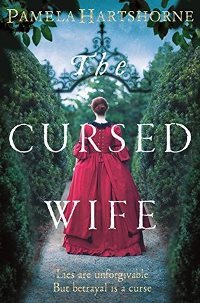
Hartshorne has written a succession of popular time-slip novels, but The Cursed Wife is set wholly during Elizabethan times. In 16th-century York, a woman who had a curse placed upon her as a child for causing another's death finds it hard to escape her past. Pan, March 2018. [see on Goodreads]
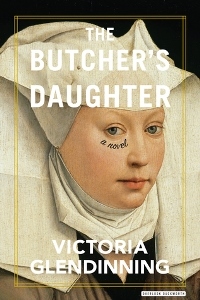
Agnes Peppin, a butcher's daughter from Dorset, gets sent to a nunnery after an indiscretion, later finding herself thrust into the world again after the Dissolution of the Monasteries. I'll be reviewing this novel shortly. Overlook, July 2018. [see on Goodreads]
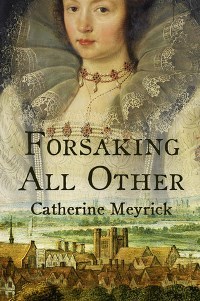
This romantic novel set in the 1580s centers on a young widow, a lady-in-waiting to a noblewoman, who seeks a better match for herself than the elderly man her father chose for her. I've purchased a copy and hope to read it soon. Courante, March 2018. [see on Goodreads]
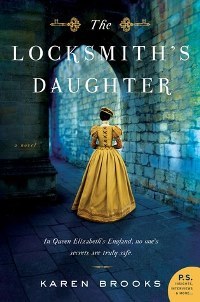
Karen Brooks' previous novel, The Brewer's Tale, delved into gender roles and society among the working classes in 15th-century England. It's worth seeking out (it's published only in Australia at the moment). Her newest moves ahead two centuries to Elizabethan times to tell the story of a young woman, an expert locksmith like her father, who gets drawn into spying for Francis Walsingham. Morrow, July 2018. [see on Goodreads]
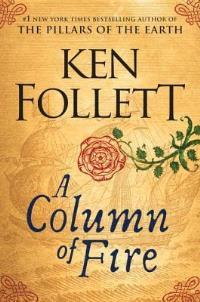
Ken Follett's fans know what to expect from his work: an epic portrait of a place and time from the viewpoints of a varied cast of characters. His newest, third in the Kingsbridge series set in a fictional English town, takes place in 1558, as religious conflict sweeps through. Viking, 2017. [see on Goodreads]
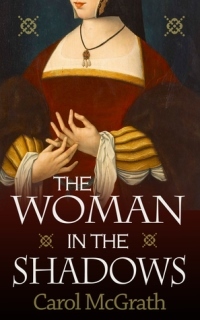
Carol McGrath's newest novel, which can be read as a prequel to Wolf Hall, focuses on Elizabeth Williams, a prosperous widow who married Thomas Cromwell as her second husband. Taking place before Cromwell's rise to fame (and notoriety), it focuses on an independent woman and her life in a Tudor merchant household. Accent, 2017. [see my review] [see on Goodreads]
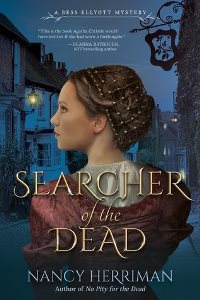
This is the debut of a new Elizabethan mystery series featuring Bess Ellyott, an herbalist from London who relocates to the countryside and follows the trail of her husband's murderer. Crooked Lane, March 2018. [see on Goodreads]

Hartshorne has written a succession of popular time-slip novels, but The Cursed Wife is set wholly during Elizabethan times. In 16th-century York, a woman who had a curse placed upon her as a child for causing another's death finds it hard to escape her past. Pan, March 2018. [see on Goodreads]

Agnes Peppin, a butcher's daughter from Dorset, gets sent to a nunnery after an indiscretion, later finding herself thrust into the world again after the Dissolution of the Monasteries. I'll be reviewing this novel shortly. Overlook, July 2018. [see on Goodreads]

This romantic novel set in the 1580s centers on a young widow, a lady-in-waiting to a noblewoman, who seeks a better match for herself than the elderly man her father chose for her. I've purchased a copy and hope to read it soon. Courante, March 2018. [see on Goodreads]

Karen Brooks' previous novel, The Brewer's Tale, delved into gender roles and society among the working classes in 15th-century England. It's worth seeking out (it's published only in Australia at the moment). Her newest moves ahead two centuries to Elizabethan times to tell the story of a young woman, an expert locksmith like her father, who gets drawn into spying for Francis Walsingham. Morrow, July 2018. [see on Goodreads]

Ken Follett's fans know what to expect from his work: an epic portrait of a place and time from the viewpoints of a varied cast of characters. His newest, third in the Kingsbridge series set in a fictional English town, takes place in 1558, as religious conflict sweeps through. Viking, 2017. [see on Goodreads]

Carol McGrath's newest novel, which can be read as a prequel to Wolf Hall, focuses on Elizabeth Williams, a prosperous widow who married Thomas Cromwell as her second husband. Taking place before Cromwell's rise to fame (and notoriety), it focuses on an independent woman and her life in a Tudor merchant household. Accent, 2017. [see my review] [see on Goodreads]

This is the debut of a new Elizabethan mystery series featuring Bess Ellyott, an herbalist from London who relocates to the countryside and follows the trail of her husband's murderer. Crooked Lane, March 2018. [see on Goodreads]
Published on April 25, 2018 05:00
April 23, 2018
Lilly Sommers' The Dark Dream, an epic of the gold rush in 19th-century Australia
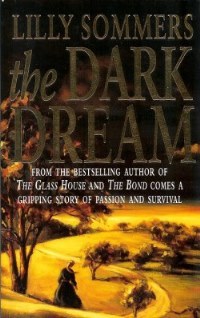 My house is full of older books I’d purchased at least a decade ago, but due to ongoing commitments, I rarely have time to read them. I was starting to feel guilty about this, though, so picked this one up after finishing my latest Booklist assignment.
My house is full of older books I’d purchased at least a decade ago, but due to ongoing commitments, I rarely have time to read them. I was starting to feel guilty about this, though, so picked this one up after finishing my latest Booklist assignment.Published by Arrow/Random House Australia in 1997, Lilly Sommers’ The Dark Dream is an epic historical adventure (of nearly 600 pages) set in the rough-and-tumble world of the Bendigo gold rush in 1852. It’s long out of print, although the style doesn’t feel dated at all, and the author is still actively writing historical novels; I have some of her latest books, written under her own name, Kaye Dobbie. I bought The Dark Dream online years ago after enjoying another novel of hers, The Bond, which I’d found in an American remainder bookstore.
The heroine goes by Ella Seaton, although her real name and identity are a mystery that unfolds throughout the book. She awakens with a painful head injury in the mud alongside Seaton’s Lagoon, not knowing who she is or why she’s there. A man rescues her and brings her to his friend Adam, a tinker on his way to the Bendigo goldfields. Adam calls her Cinderella – Ella for short – after finding a pair of discarded leather shoes nearby and seeing that they fit her.
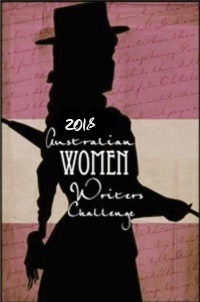 Ella and Adam assume she was set upon by bushrangers and robbed. One of her fingers bears the mark of a ring, so they know she was married. As Adam cares for her during her recovery, they make their way via horse-drawn cart to the goldfields, tracing the route Ella may have originally followed, hoping someone can identify her. However, Adam has own secrets, dating back to his days as a California forty-niner. The dangers they face derive as much from Adam’s troubled past as Ella’s present situation: her lack of memory leaves her vulnerable to enemies she can’t anticipate.
Ella and Adam assume she was set upon by bushrangers and robbed. One of her fingers bears the mark of a ring, so they know she was married. As Adam cares for her during her recovery, they make their way via horse-drawn cart to the goldfields, tracing the route Ella may have originally followed, hoping someone can identify her. However, Adam has own secrets, dating back to his days as a California forty-niner. The dangers they face derive as much from Adam’s troubled past as Ella’s present situation: her lack of memory leaves her vulnerable to enemies she can’t anticipate. Storylines involving amnesia can sometimes feel contrived, but to Sommers’ credit, her portrayal of Ella’s condition feels honest. Ella innately senses that she was gently born, and although she’s grateful for Adam’s help, she’s clearly uncomfortable with camping in the bush, the lack of cleanliness, and treating folks like Adam and his acquaintances as social equals. This allows for considerable character growth as the plot moves along. Flashes of Ella’s earlier life come to her in dreams she can’t recall after waking. I particularly liked the scene where she glimpses herself in a mirror for the first time, and fails to recognize herself immediately. My one problem with the storyline was Ella’s naïve assumption that returning to her husband should be her ultimate goal, even given evidence to the contrary.
I recommend the book for its exciting plot, slow-building romance, and depiction of the characters (some brave, some foolish, many disreputable) caught up in the Victorian gold rush. Anyone seeking The Dark Dream can find a cheap copy via Bookfinder. And maybe it will be re-released on Kindle some day.
This is my 2nd entry in the Australian Women Writers Challenge for 2018.
Published on April 23, 2018 06:33
April 20, 2018
Gateway to the Moon by Mary Morris, a historical epic about the crypto-Jews of New Mexico
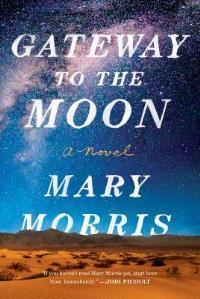 Where do we come from? Focusing on the crypto-Jews of the American Southwest and their European ancestors, Morris’ (The Jazz Palace, 2015) enthralling saga ponders this question in both a genealogical and astronomical sense.
Where do we come from? Focusing on the crypto-Jews of the American Southwest and their European ancestors, Morris’ (The Jazz Palace, 2015) enthralling saga ponders this question in both a genealogical and astronomical sense.Seeking extra spending money, 14-year-old Miguel Torres, an amateur stargazer from a tiny New Mexican town in 1992, takes a job babysitting the two young sons of Rachel Rothstein, a lonely, restless artist and doctor’s wife. Full of typical adolescent preoccupations, and curious about his place in the universe, Miguel tries to serve as a positive role model for the boys while noting the odd familiarity of the Rothsteins’ Jewish traditions.
A parallel plotline follows the story of Luis de Torres, a converso interpreter on Columbus’ first voyage forced to conceal his faith. Magnificent characters with complex psychologies, including adventurous entrepreneurs and several courageous women, populate this generational tale of the Sephardic diaspora. Their lives alternate between periods of relative peace and persecution, since the deadly Inquisition is ever vigilant.
Over time, memories of their Jewishness vanish, though some traditions endure. The descriptions of culinary specialties are especially divine.
The story glides effortlessly between viewpoints and vibrant settings ranging from Lisbon to Tangier, the Caribbean, and Mexico City. With prose as clear as the star-strewn night sky, Morris’ novel explores people’s hidden connections.
I wrote this (starred) review for Booklist's March 15th issue. This was my first time reading one of Mary Morris's novels.
Some other notes:
- The title, Gateway to the Moon, is the translation of Entrada de la Luna, the New Mexican town where Miguel lives.
- There's an academic society, the Society for Crypto-Judaic Studies, geared toward "researching the history of crypto-Jewish and Sephardic communities around the world"; it has an associated journal.
- For other novels on this subject, see Daniella Levy's By Light of Hidden Candles and Kathryn Lasky's YA historical novel Blood Secret.
- Read more about the subject, the controversy, and the genetics at Smithsonian Magazine: "The 'Secret Jews' of San Luis Valley."
Published on April 20, 2018 05:23
April 16, 2018
Review of Charles Frazier's Varina, about the Confederacy's unlikely first lady
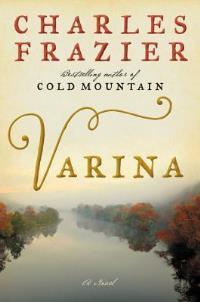 What legacy befalls those who find themselves on history’s wrong side? Frazier’s (Nightwoods, 2011) fourth Southern historical novel centers on Varina Howell Davis, the unlikely first lady of the doomed Confederacy.
What legacy befalls those who find themselves on history’s wrong side? Frazier’s (Nightwoods, 2011) fourth Southern historical novel centers on Varina Howell Davis, the unlikely first lady of the doomed Confederacy.Its nonlinear structure roams across her tragic life’s vast landscape, from her girlhood as an impoverished Mississippi planter’s well-educated daughter to her strained marriage to the much-older Jefferson Davis to old age in a Saratoga Springs rest home. There, regular visits from James Blake, an African American man she’d taken in as a child, prompt her recollections.
Frazier crafts haunting scenes of her and her children’s flight from Richmond via wagon through the devastated South and her morphine-hazed, funereal view of her husband’s rain-soaked inauguration.
Intelligent, outspoken, and clear-sighted but yoked to an intransigent man, the real Varina (who is called “V” throughout) sometimes feels elusive. One wonders what she could have become under different circumstances.
In her conversations with James, she proclaims “the right side won” yet seems unable to fully grasp slavery’s ramifications. This powerful realization of its time also has significant meaning for ours.
Charles Frazier's Varina is published this month by Ecco, an imprint of HarperCollins. I wrote this review for Booklist's March 1 issue. Frazier is best known, of course, for Cold Mountain, a book I've yet to read (!). I enjoyed his Thirteen Moons, particularly the quality of writing, although I felt the protagonist's love interest wasn't fully three-dimensional.
For more information on the novel's background, read an interview with the author from the News & Observer (Raleigh, North Carolina).
Published on April 16, 2018 05:00
April 12, 2018
By Love Divided by Elizabeth St. John, an epic of the English Civil War years
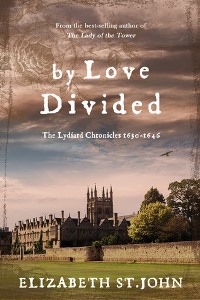 The novels in Elizabeth St. John’s Lydiard Chronicles are standouts in the recent resurgence of historical fiction set in 17th-century England. The first book, The Lady of the Tower, was seen from the first-person perspective of Lucy St. John of Lydiard Tregoze, a young noblewoman who came to marry Sir Allen Apsley, Keeper and Lieutenant of the Tower of London in Jacobean times.
The novels in Elizabeth St. John’s Lydiard Chronicles are standouts in the recent resurgence of historical fiction set in 17th-century England. The first book, The Lady of the Tower, was seen from the first-person perspective of Lucy St. John of Lydiard Tregoze, a young noblewoman who came to marry Sir Allen Apsley, Keeper and Lieutenant of the Tower of London in Jacobean times. Moving seamlessly into third person, this sequel follows Lucy, now widowed and trying to stave off her husband’s creditors in court, and her two eldest children, Allen and Luce, as their declined fortunes and political loyalties force them into irrevocable decisions that shift their paths.
Having absorbed different views from their parents, Allen and Luce find themselves on opposite sides of the coming English Civil War. Believing strongly that “the king is as a father to the people of this nation,” Allen becomes a prominent courtier and Cavalier, later accompanying his Villiers cousins into war. Luce, however, takes Parliament’s side, having seen firsthand how Charles I’s French wars drove her family into near-penury.
While acknowledging her “Calvinist soul” and sympathizing with Luce, Lucy hates seeing how her children are divided and hopes that war won’t tear her family apart. At the same time, she doesn’t hold her viewpoints back. In one revealing scene back at her birthplace, she makes her thoughts clear about her younger brother John’s monarchist views and pretentiousness.
With so many moving parts, the issues that brought England into civil war are complex and can be challenging to grasp. However, this epic novel exemplifies the fact that history is created from people’s individual stories, which makes the concepts easy to absorb. The author draws readers into the prevailing sentiments of the era from multiple angles, and from domestic life to battles and military campaigns – including incidents rarely shown in fiction, like Charles I’s attempt to impose the Anglican prayer book on Scotland.
Generational lessons are learned, as Lucy shares her reasons for her avoidance of court life with her daughter, and Allen grows up and fights to restore the Apsleys’ fortunes. The story delves deeply into two opinionated women’s lives and unavoidable choices, and depicts two love stories – which are equally romantic, for different reasons.
By Love Divided is a lengthy book (over 9000 lines on my Kindle), and readers already enamored of the 17th century years should delight in the plentiful details. Newcomers should also welcome this introduction to the English Civil War and a prominent family active at that time. For me this series is also a natural recommendation for anyone who grew up reading Pamela Belle’s Herons of Goldhayes series, a longtime favorite.
The novel was published last October by Falcon Historical in pb and ebook. Thanks to the author for sending me an ebook copy.
Published on April 12, 2018 05:30



